#angora fiber
Explore tagged Tumblr posts
Text
Okay i am still procrastinating on a larger/more comprehensive post but heres some of the colors i have so far from lichens, both AM and BWM (Ammomia method, sometimes called ammonia fermentation but there's no actual bacterial activity; then the boiling water method, literally what it sounds like)
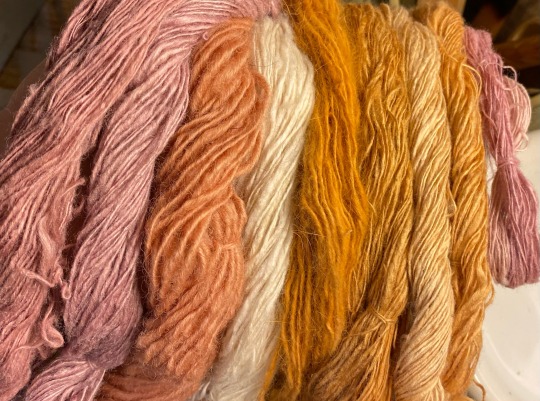

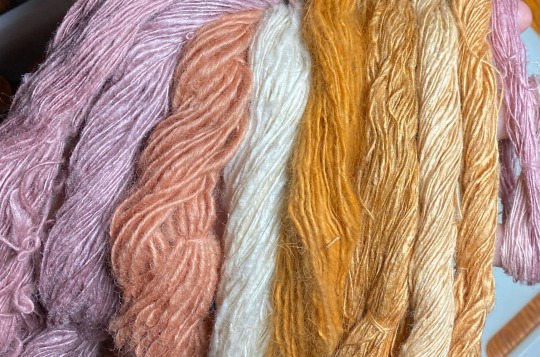
I took them under 3 different indoor light sources to try to show the variance of the colors, sadly not the sun as it is hiding behind the clouds as of late
from left to right: first two lavender-like purple are silk, dyed with an fuzzily-ID'd lecanora/ochrolechia like lichen that was AM prepared; the second one used the same lichens but prepared different (second ammonia soak)
the third one is wool using a similar lichen that was also AM prepared, i was almost worried it wouldnt work/i messed up the vat because i set the pH too low but surprisingly it didn't brown out and turned a lovely pink salmon color
the white is the base color of the silk
the fifth one is some french angora rabbit that i dyed using ruffle lichens via the BWM method; a lovely intense orange
the 6th and 8th were dyed with ruffle lichens (BWM) as well a long time ago so i don't recall the details
the 7th was dyed with usnea lichens (BWM) around the same time as 6 and 8
Finally, the last two tiny strings were AM dyed a long time ago and i almost forgot about making them!
Of course, all lichens should be collected from deadfall, not directly from a tree/rock/etc to avoid overharvesting. It's also important to keep chemical safety in mind if you work with ammonia, or even things like alum and vinegar!
All the yarn was spun myself on a drop spindle too, after dyeing the fiber clouds (very technical term i know)
I have more posts i want to make on lichen dyes and the making/using thereof once i get my head screwed back on correctly, specifically some recent shenanigans concerning the first three yarns! the chemical pigment itself, the history, the troubleshooting, etc. Which i think will be very cool
Bonus drop spindle, and a ruffle lichen comparison!
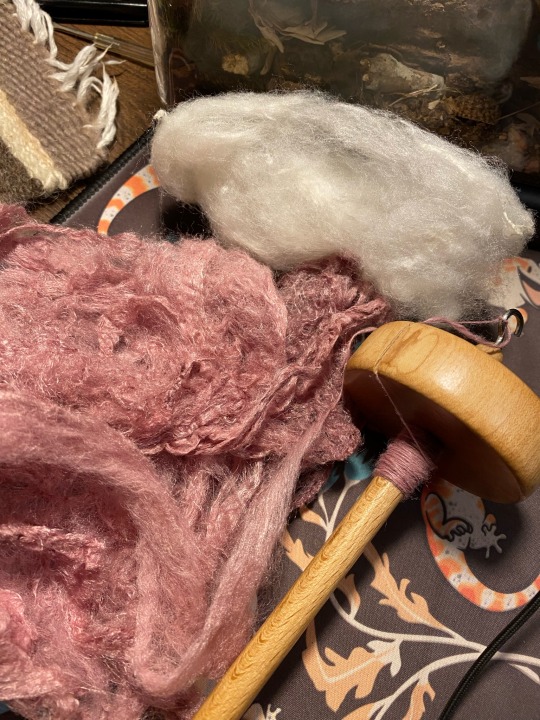
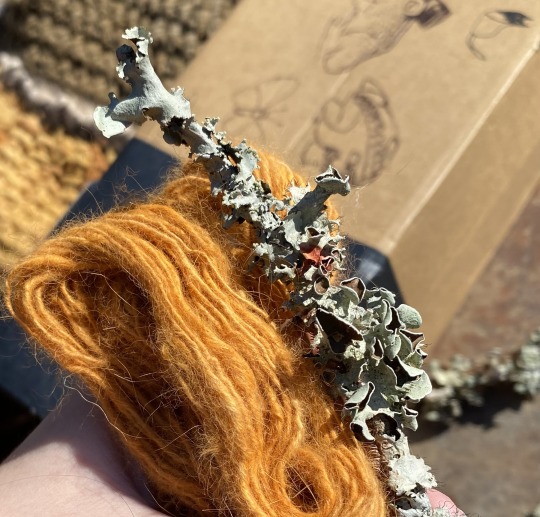
You can even see an orange spot on the otherwise minty slate green of the ruffle lichens where it had started to decompose!
#fiber arts#yarn#eri silk#wool#angora fiber#handspinning#natural dyeing#art#earth skills#crafts#ammonia fermentaion#lichen dyes#drop spindle
455 notes
·
View notes
Text
This is going to be me at the Fiber Festival tomorrow. I cannot wait to get my hands on local angora and wool!
Guilty as charged 😁✌️
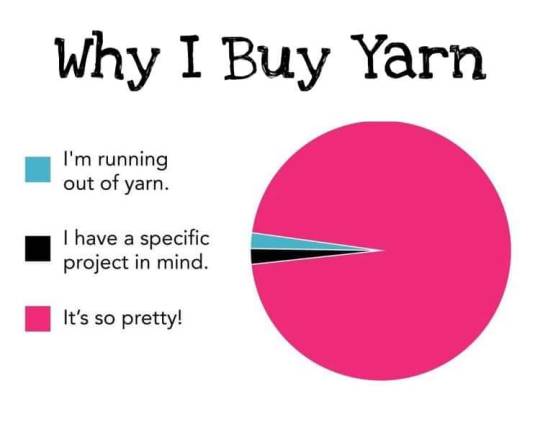
980 notes
·
View notes
Text
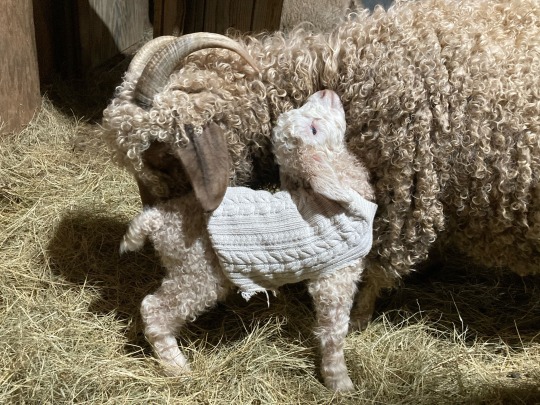
Mother and newborn
#goats#stonywoods farm#mohair#angora goat#farm#furry#curly#farm animals#cute baby goat#angora#animals#goat#fiber#fibre#baby animals#baby goats#goats in clothes#goats in coats#all dressed up#colored angora goats#baby colored angora goat#baby animal#baby angora goats#angora goats#mohair on the hoof
17K notes
·
View notes
Text

Meet Peppercorn!
Born 4/5/2024 Peppercorn is a satin x french black angora rabbit. She’s a picky eater with two speeds, chilling or zoomy binky machine. She came to me shorn and I’m so excited to see how her coat grows out.
20 notes
·
View notes
Text

angora is a geep plushie whos geepussy is a ripped seam with a cute lil button clit 💕🧸 she gets sewn up as aftercare by her owner and loves it 🪡💕🩷💞🩷💞🩷💞🩷
21 notes
·
View notes
Text
thinking about preston learning how to knit/crochet… give that man some hobbies that aren’t Having Survivors Guilt and Alcoholism
#also imagining the crazy ass giant angora rabbits u could use for yarn spinning.#fiber artists curse#not art
36 notes
·
View notes
Text

my fursona Angora! she is a magical geep plushie. shes crocheted and its eyes are wet felted w wool and silk and hand stitched together. made by my hands and I love her 🐑🐏🧶💞✨

#fursona#furry#geep#fiber art#crochet fursuit#fiber artist#fiber furry#fiberous planet#sheep furry#goat fursona#sheep fursona#plushie#plushie furry#plushie posting#angora
15 notes
·
View notes
Text
COME CHECK OUT MY MAKERPLACE STORE
https://www.michaels.com/makerplace/storefront/little-brown-bat-ranch
I have metaphysical jewelry!!! Soon I will have EVEN MORE JEWELRY and eventually I will have GOAT FIBER. AND BEE PRODUCTS!!! But our hive is in its first year so we may not have any honey or wax to harvest until next year, but still!



#earrings#small business#hand made jewelry#goats#angora goat fiber#homesteading#little brown bat ranch#queer owned business#please buy something i am very poor and a tree fell on my house#metaphysical jewelry
2 notes
·
View notes
Text
tdf update 1:
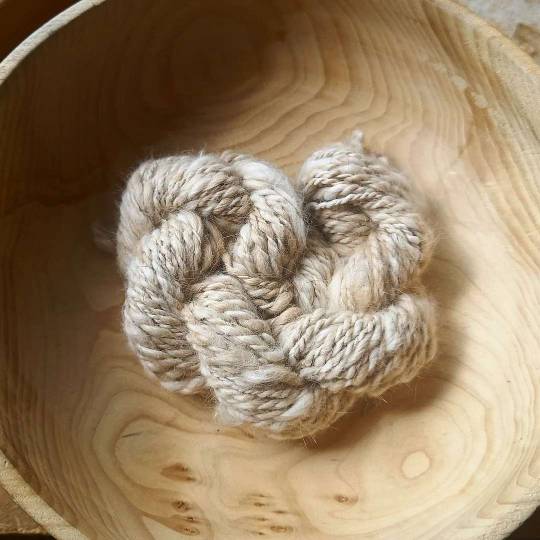
[ID in ALT]
first project of tdf is done! a small and slightly uneven skein of 100% angora yarn. the fiber was bought as "second class" so the staple length was all over the place, hence the unevenness, but despite this it was a joy to spin :D
#my stuff#fiber art#tdf#tdf 2023#tour de fleece#handspun#handspun yarn#hand spinning#angora yarn#i have some of the fibre left and im considering mixing it with either wool or silk#also ive decided to do tdf updates when i finish a project with the possibility of other updates if i snap a good wip pic#also also tumblr is yet again refusing to let me post images from my phone so i had to wait till i had my laptop to post this....#AND the image i transferred from my phone via a cable also did not want to upload so i had to download the version i shared on discord#so if the quality is noticably shit thats why
8 notes
·
View notes
Photo
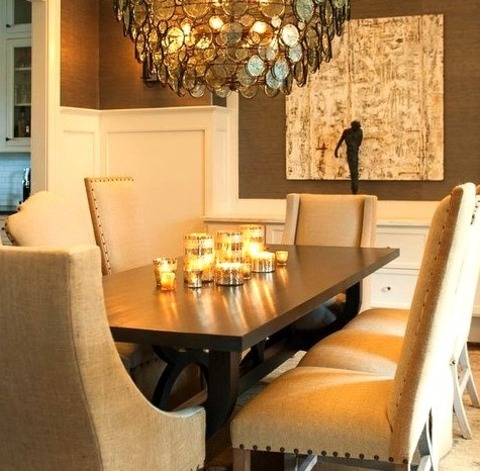
Dining Room Kitchen Dining Atlanta An expansive transitional kitchen/dining room design example
#handmade turkish rugs#100% hand spun#genuine turkish angora ushak/oushak rugs#handspun wool rugs#natural fibers#turkish rugs#natural dye
0 notes
Text
no but i saw a video of a woman spinning angora fiber into yarn directly from the bunny in her lap and it changed my brain like
the clothes on our body used to come from the animals we cared for. that's crazy! imagine loving and caring such a sweet lil creature, making soft warm clothes for yourself using fiber from your favorite sheep. clothes that will likely outlive the creature who provided the fiber. we loved and cared for these creatures and then carried a part of them with us. and some people still do! i'm so emotional about this i need a minute
201 notes
·
View notes
Text
see many people do this >:)
*coral = color
** EEW 6 = electric spinning wheel
*** said mohair fleece can be combed into functional fiber to spin w patience n strength
**** rainbow mini sheep (rainbow not in order)
151 notes
·
View notes
Text
MISSION ACCOMPLISHED
Things I would like from the fiber fair this weekend in order of priority:
Buttons (for the shirt I'm crocheting right now)
Rolags (as I haven't spun with them before)
Angora, Cashmere, or Mohair (as I haven't spun them yet)
Sock blockers (to finally entice me to finish my socks?)
Rambouillet (as it has been my favourite to spin by a mile)
Crochet patterns? (still mulling over all this Mohair yarn...)
#dryad speaks#dryad dabbles#fiber fusion northwest#i stayed within budget!#got angora and cashmere to spin (just natural white)#got some alpaca/silk rolags (in a beautiful purple/pink/teal on black color)#and got some cute laser etched wooden peony buttons for my shirt#i think next year i want to do some classes over the weekend#but we'll see what they're offering!#sadly i could not find any rambouillet in a color i liked#but that's fine bc i still have fiber from last year to spin
5 notes
·
View notes
Text
Not even a week old
#goats#stonywoods farm#mohair#angora goat#furry#farm#curly#farm animals#cute baby goat#angora#animals#fiber#fibre#goat#baby animals#baby goats#cute baby#cute animals#baby colored angora goat
3K notes
·
View notes
Text
Fibers in Fiction - A Silmarillion Writer’s Guide to Þerindë's Craft
It's the @silmarillionwritersguild's Meta Week, and I wanted to contribute my two special interests -- fiber art and Tolkien -- and my real world degree in Medieval European Women's History. So here's a essay with writing resources for Day 6 - apply real-world disciplines to Middle-earth.
Most of this I had sitting in the back of my head and do not have quality, academic sources for. Links are either to written or video resources, or to picture credits.
Intro
What is fiber art? My personal definition is the manipulation of some sort of fiber into something functional and/or beautiful. There are a few characters in Tolkien’s works that are associated with a fiber craft of some sort – Vairë the Weaver, Míriel Þerindë, and Arwen Undómiel come to mind the easiest. I've seen various fanworks that have Caranthir also be a needle-worker, but that's not canon the way these three women are. There's a lot to be said about the intersection between "women's work" and needlework and feminism, and Tolkien's inclusion of those patriarchal standards, but ... that's not this essay.
There’s a lot of methods and a lot of disciplines that can be put under the umbrella of fiber art. The purpose of this essay is to help fic writers expound on the process of a fiber craft using the correct terminology, gain an understanding of period(ish) appropriate tools/techniques, and the differences between some of the major forms of fiber arts.
What is a fiber?
Starting with the basics. A fiber is a material that is longer than it is wide and typically used in textiles or electronics. This is Tolkien’s world, we’re not worrying about electronics, so let’s turn to textile fibers. There are four main types of textile fibers:
natural fibers - flax, hemp, cotton, jute
animal fibers - silk, wool, catgut (not made from cats), angora rabbit fur, goat hair (mohair, cashmere)
synthetic fibers. - polyester, acrylic, nylon, rayon
Metallic fibers - gold, silver, copper, mithril that have been formed into a very thin wire
Obviously, unless the Valar let Fëanor get into oil extraction, all those synthetic fibers are right out. Leatherwork does not count as a fiber art, since true leather is a processed animal skin. Cords can be cut from leather to act like string, but that’s not a true fiber. And don’t talk to me about pleather or vegan leather. That’s just plastic and it’s bad for the environment.
Spin a Thread, Draw a Wire
For the three types of fiber that could be used in Arda, there are two methods to turn these materials into thread: drawing and spinning.
Drawing a wire: a small piece of metal is pulled through a device called a draw plate. A draw plate may have many holes through which the wire is pulled, each getting successively smaller and smaller until you reach the gauge (size) you desire. As you pull the wire through each smaller hole, the wire gets thinner and longer. Rinse and repeat until you have a wire of the desired thickness. If you’re combining a wire with some sort of flexible fiber (couching, weaving, etc, see below) it needs to be extremely thin in order to be flexible enough to bend with the fiber it’s attached to.
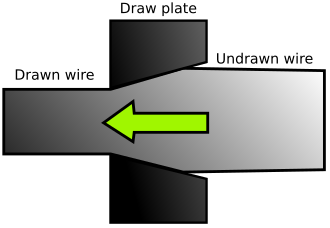
You need a lubricant to ensure the wire doesn’t get stuck in the draw plate. Covering the wire in oil is a good way to go (this is called dry drawing. Wet drawing is when the draw plate and the wire are both submerged in oil as you work). Application of heat can make this process easier, but depending on the metal, you might not need very much.
Gold, silver, and copper are all very soft metals in their purest form -- alloys will make them stronger, less malleable, and harder to draw. Mithril, given that it’s a fictional metal, I can’t confidently comment on, but it’s said to have been very malleable, so I would imagine that the same process for creating very thin wires would also work in the same way as it would for the other metals listed.
A spun thread is an assortment of individual fibers that have been twisted together to make a stronger unit. Natural, animal, and synthetic fibers can all be spun.
Usually when we describe something as a thread, we’re talking about a spun fiber that is fine/thin and smooth enough for sewing or weaving applications. Spinning a thread involves taking a pile of washed and combed but loose fibers (a bundle of these is called a roving) and literally twisting it until it forms a thread. This can be done with a drop spindle or a spinning wheel. A drop spindle is the more mobile form of spinning, and simple enough that medieval families would often have children spin. With practice you could even do it while walking. Imagine, for a moment, Míriel Þerindë walking through Beleriand during the Great Journey, drop spindle in hand, making the thread she is known for. That’s some good stuff. I’m begging somebody to write this.
Here’s some video tutorials on how to use a drop spindle and how to use a spinning wheel. I can’t explain it succinctly, and a visual is always a good tool.
Plyed Threads Make a Yarn
Yarn is several threads counter-twisted around each other. Counter twisting is what holds the yarn’s structure. If the individual thread is twisted clockwise, the yarn must twist all those clockwise threads counterclockwise. The tension holds the shape of the yarn.

Yarns (usually made from an animal fiber like wool, goat, or angora) and twines (usually made from natural fibers like hemp or jute or cotton) are made the same way because they make the threads stronger and more durable than they would be as individual threads, but their material usually dictates how they’re used. Yarns are softer, better for knitting or crochet or weaving. Twines and cords tend to be rougher, better for securing things to other things, for outdoor use, or … you know. The things they do in Angband.
Weaving a fabric
So you’ve got your thread and/or yarn. Now what? Well, you can dye it now (see next section), you can start knitting a garment (you need good socks on the Helcaraxë), or you can start weaving a fabric. Fabric has two components, both made by individual threads in sequence. The warp is generally static, and the vertical thread in most diagrams, including the ones I’m including here. The weft is the thread that passes back and forth horizontally. You can have the weft go over/under/over/under like this diagram (this is called a plain weave) or you can have the weft skip over a number of warp threads to create a pattern or a texture (satin or twill or denim weaves skip warp threads). The pattern depends on which warp threads get lifted or lowered with each pass of the weft, which is typically attached to a shuttle that glides through the shed.

Weaving requires a loom, but that loom can come in various form-factors. A backstrap loom maintains tension in the warp by the position of the weaver, who has a strap attached to the loom going around her back while she manipulates the weft in front of her. This was, and still is, commonly used in native South American communities.

Early medieval Europe typically used a warp-weighted loom, where the warp threads were tied to a loom weight that dangled off the back of the loom frame. This was replaced later with the horizontal loom, which included the invention of heddles (loops that lifted warp threads in sequence to make a shed (opening) so as to make a pattern) and treadles (foot pedals that control the heddles).
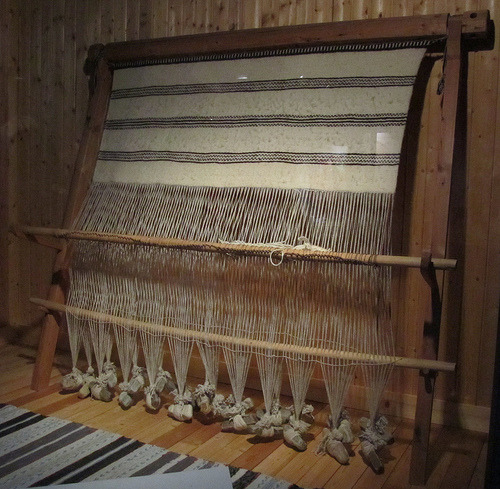
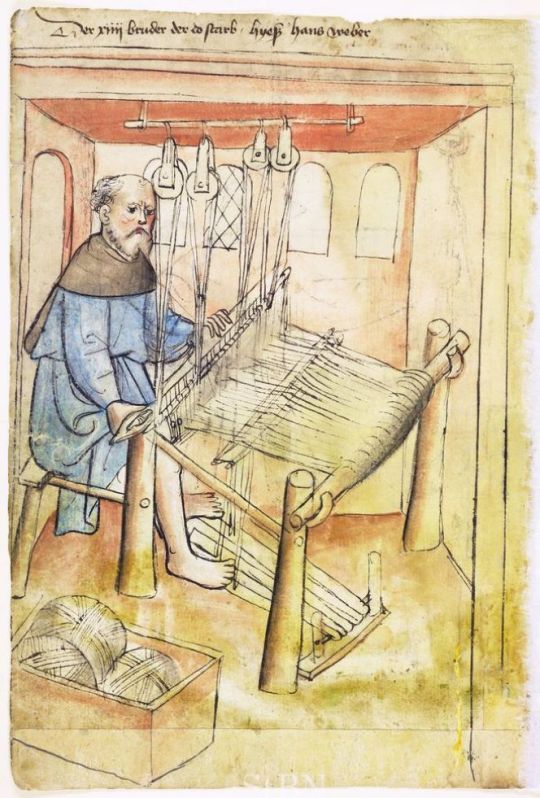
Later, the horizontal loom gets mechanized, and somehow we got computer programs out of Jacquard looms. Fascinating, but not relevant here.
One of my favorite types of weaving is tablet weaving, which instead of heddles or treadles to form the shed, uses square cards. Four threads go through the corners of the cards to form alternating sheds that can form complex patterns. Tablet weaving is great for decorative trim and edges. You can use a backstrap method, a warp weighted method, or an inkle loom to create tablet woven articles. This video is a gorgeous introduction, but a bit long.
What about Vairë’s tapestries, I hear you cry out into the Void? See below :)
Add a splash of color, become ungovernable
Color! The world can create rainbows, and we’ve been trying to make thread to match for ages. Luckily you can make most colors with natural dyes. Purple is the hardest color to get with a natural dye, along with blacks; yellows and reds and browns are easiest.
You have to prepare your dye (usually taking some natural material (onion, cochineal insects, gallnuts, walnuts, marigold flowers, woad, madder, whatever you have) and your thread/yarn/fabric separately before combining them with heat.
Prepping your dye depends on the material you’re using. Sometimes it’s just an overnight soak in a pot, sometimes it’s crushing beetle carcasses into a fine powder, sometimes it’s boiling. I leave it to you, friend, to research the exact color you’re looking to make with a natural dye and how to get that, but this chart might be a good start.

Most thread/yarn/fabric needs a mordant. Mordant is a dye fixative. After all that work making the fabric, you don’t want that gorgeous Fëanorian red (madder root) to come out in the wash water, right? Mordants are acids that can be found naturally, either by processing some plant materials to create tannic acid (oak trees and oak galls) or oxalic acid (wood sorrels), or by working a chemical process using alum, chrome alum, or sodium chloride, or ammonia (stale urine was commonly used before modern chemical processes). Mordants stink to Angband and back, so historically dyers would be outside town or in their own district as to not offend everyone elses noses.
You can get a richer, more saturated color by overdyeing – dying twice or even three times. Dyes are hard to color match; each batch is going to have its own variables (weather, temperature, concentration of the dye, concentration of the mordant, quality of the fiber, etc).
I’ve found this website that goes into a lot more detail. I’m not affiliated with them, but it’s a good starting point.
Tools
A non-exhaustive list of standard tools a fiber artist may use and material it could be/typically is made of:
Thread, yarn, or fabric (described above)
Scissors/shears (metal)
Sharp sewing needle in various sizes (bone or metal)
Blunt needle in various sizes (sometimes called a tapestry needle, bone or metal)
Spindle (wood)
Loom in various sizes (wood, wire, thread)
Shuttle (wood)
Knitting needles (bone, wood, or metal)
Nalbinding needle (bone, metal) (nalbinding is a cousin of knitting and crochet, good for hats and socks)
Crochet hook (bone, metal, wood)
Bobbin (wood, bone)
Lace pins (metal)
Lace pillow (fabric)
Embroidery hoop (wood)
Embroidery frame (scroll frame, slate frame, wood)
Embroidery stand (wood, metal)
Thimble (leather, metal)
Fiber Crafts seen in the Legendarium
Tapestry Weaving
Tapestry weaving is different than standard weaving, because the weft does not go across the entire length of the working area in a shuttle. Tapestry weaving typically uses many, many bobbins or needles of colored thread worked in a plain weave in small areas to make an image. In medieval Europe, tapestries would be used as a form of insulation, to keep the cold out, and as a status symbol. (All I’m saying is, give Himring more tapestries, and maybe the Ever-Cold fortress would be a bit more homey). Here’s this article from the Metropolitan Museum of Art about tapestries, and here’s a video about the making of large scale tapestries, which is the technique I imagine Vairë and Míriel use for the Halls.

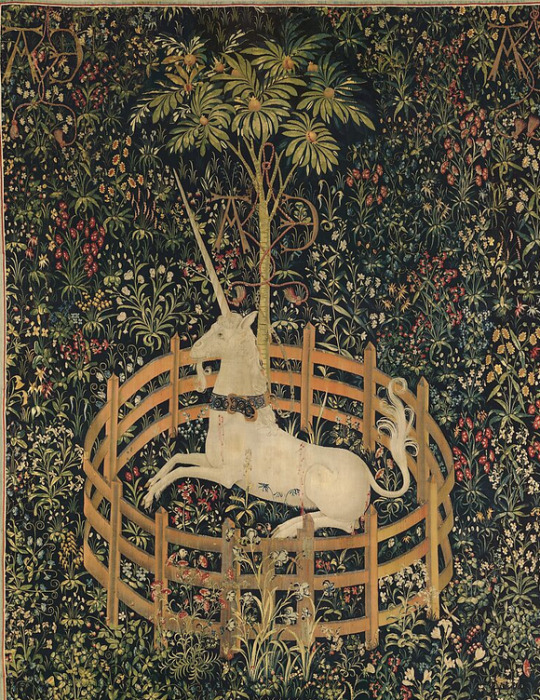
Embroidery
Embroidery is the practice of taking individual colored threads (usually cotton, wool, or silk) and sewing them into a ground fabric to decorate that fabric with a design of some sort. There’s SO MANY ways to embroider things. Cross stitch, which is what your author started out doing, uses stitched squares on a grid to effectively make pixel art with thread. You can do blackwork (which doesn’t necessarily need a black thread) which makes a repeating pattern on a grid but doesn’t make squares. Or there’s more freeform embroidery which lots of people use for natural scenes (flowers especially) but can be used for portraits, landscapes, silly sayings – the world is your oyster. The Royal School of Needlework in the UK has a Stitch Bank which documents how to accomplish many, many, many kinds of stitches.
I’m going to highlight a few stitches that absolutely should be in your writing toolkit if you are working with a character doing embroidery. I’m not going to describe every stitch, but knowing what a stitch is called is half the battle. Okay, maybe a quarter of it, you still have to either do it, or write a good description of doing it, which may be the other 3/4ths of the battle.
Satin Stitch - a good, all purpose filler. Made by stitching parallel lines of thread. Uses a lot of thread, since you should be bringing your needle up through the ground on the same side of the thing you’re trying to fill every time.
Couching - another good, all purpose filler. Made by laying thread or wire flat on the ground fabric, then taking another thread (close in color or not, depends on the vibe) and stitching it down in place securely. This is the main filling stitch in the Bayeux Tapestry (not a true tapestry, it’s just a really big embroidery) and undoubtedly how Arwen made part of Aragorn’s banner with mithril wire.
Straight stitch - makes a dashed line
Back stitch - makes a solid straight line
Stem stitch - makes a solid straight line that can easily curve
Chain stitch - good filler, makes interlocking loops
Daisy stitch - a chain stitch that doesn’t interlock the loops, but stitches down the loop so it doesn’t move. Makes good simple flowers
French knots - tiny filler, lots of good texture. Tiny knots made by wrapping the thread around your needle.
Stump work - 3D effects for ages. Want flowers or leaves to literally jump off the ground fabric? Stump work is your friend, and my personal nemesis.
Conclusion
Knowing the terminology of a craft is integral to learning more about it, and writing it accurately. My hope with this resource is that you might have learned a new term or two, or gotten a few new resources to use in your writing. Even better if this is something you don’t know a lot about, or have never given much thought to, then I hope you’ve learned something valuable here.
53 notes
·
View notes
Text


Im not sure i ever formally introduced Angora (she/it)! She is my fursona a magical geep plushie who eats yarn 🩷

i crocheted her and wet felted its eyes with wool and silk and then handstitched her together���� it was all very intimate 🧶🐏💖
18+ interaction only pls
18 notes
·
View notes